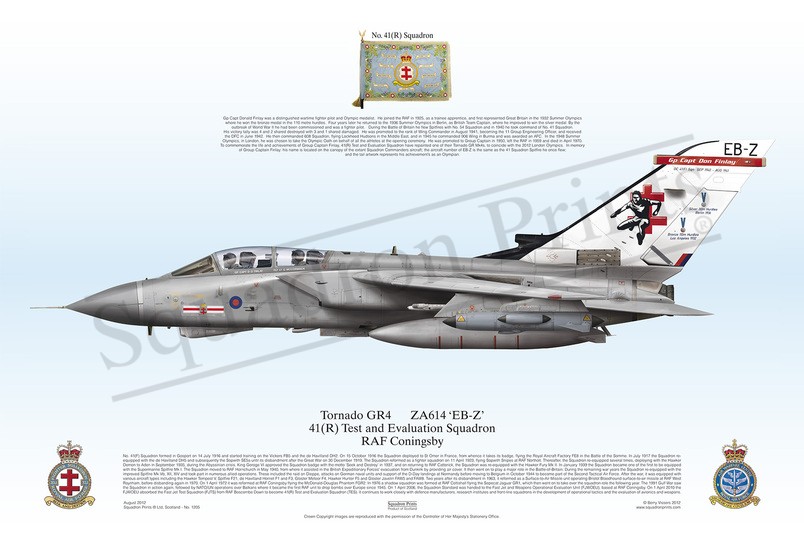#1205 Tornado GR4

Purchased products will not feature the Squadron Prints watermark
Description
Squadron Prints Lithograph No.1205 - Tornado GR4, ZA614 \'EB-Z\', 41(R) Test and Evaluation Squadron, RAF Coningsby, Olympics 1932, Olympics 1936.
No. 41(F) Squadron formed in Gosport on 14 July 1916 and started training on the Vickers FB5 and the de Havilland DH2. On 15 October 1916 the Squadron deployed to St Omer in France, from whence it takes its badge, flying the Royal Aircraft Factory FE8 in the Battle of the Somme. In July 1917 the Squadron re-equipped with the de Havilland DH5 and subsequently the Sopwith SE5a until its disbandment after the Great War on 30 December 1919. The Squadron reformed as a fighter squadron on 11 April 1923, flying Sopwith Snipes at RAF Northolt. Thereafter, the Squadron re-equipped several times, deploying with the Hawker Demon to Aden in September 1935, during the Abyssinian crisis. King Geroge VI approved the Squadron badge with the motto \'Seek and Destroy\' in 1937, and on returning to RAF Catterick, the Squadron was re-equipped with the Hawker Fury Mk II. In January 1939 the Squadron became one of the first to be equipped with the Supermarine Spitfire Mk I. The Squadron moved to RAF Hornchurch in May 1940, from where it assisted in the British Expeditionary Forces\' evacuation from Dunkirk by providing air cover. It then went on to play a major role in the Battle-of-Britain. During the remaining war years the Squadron re-equipped with the improved Spitfire Mk Vb, XII, XIV and took part in numerous allied operations. These included the raid on Dieppe, attacks on German naval units and support of the D-Day landings at Normandy before moving to Belgium in October 1944 to become part of the Second Tactical Air Force. After the war, it was equipped with various aircraft types including the Hawker Tempest V, Spitfire F21, de Havilland Hornet F1 and F3, Gloster Meteor F4, Hawker Hunter F5 and Gloster Javelin FAW5 and FAW8. Two years after its disbandment in 1963, it reformed as a Surface-to-Air Missile unit operating Bristol Bloodhound surface-to-air missile at RAF West Raynham, before disbanding again in 1970. On 1 April 1972 it was reformed at RAF Coningsby flying the McDonald-Douglas Phantom FGR2. In 1976 a shadow squadron was formed at RAF Coltishall flying the Sepecat Jaguar GR1, which then went on to take over the squadron role the following year. The 1991 Gulf War saw the Squadron in action again, followed by NATO/UN operations over Balkans where it became the first RAF unit to drop bombs over Europe since 1945. On 1 April 2006, the Squadron Standard was handed to the Fast Jet and Weapons Operational Evaluation Unit (FJWOEU), based at RAF Coningsby. On 1 April 2010 the FJWOEU absorbed the Fast Jet Test Squadron (FJTS) from RAF Boscombe Down to become 41(R) Test and Evaluation Squadron (TES). It continues to work closely with defence manufacturers, research institutes and front-line squadrons in the development of operational tactics and the evaluation of avionics and weapons.
Gp Capt Donald Finlay was a distinguished wartime fighter pilot and Olympic medalist. He joined the RAF in 1925, as a trainee apprentice, and first represented Great Britain in the 1932 Summer Olympics where he won the bronze medal in the 110 metre hurdles. Four years later he returned to the 1936 Summer Olympics in Berlin, as British Team Captain, where he improved to win the silver medal. By the outbreak of World War II he had been commissioned and was a fighter pilot. During the Battle of Britain he flew Spitfires with No. 54 Squadron and in 1940 he took command of No. 41 Squadron. His victory tally was 4 and 2 shared destroyed with 3 and 1 shared damaged. He was promoted to the rank of Wing Commander in August 1941, becoming the 11 Group Engineering Officer, and received the DFC in June 1942. He then commanded 608 Squadron, flying Lockheed Hudsons in the Middle East, and in 1945 he commanded 906 Wing in Burma and was awarded an AFC. In the 1948 Summer Olympics, in London, he was chosen to take the Olympic Oath on behalf of all the athletes at the opening ceremony. He was promoted to Group Captain in 1950, left the RAF in 1959 and died in April 1970. To commemorate the life and achievements of Group Captain Finlay, 41(R) Test and Evaluation Squadron have repainted one of their Tornado GR Mk4s, to coincide with the 2012 London Olympics. In memory of Group Captain Finlay: his name is located on the canopy of the extant Squadron Commanders aircraft; the aircraft number of EB-Z is the same as the 41 Squadron Spitfire he once flew; and the tail artwork represents his achievement\'s as an Olympian.
